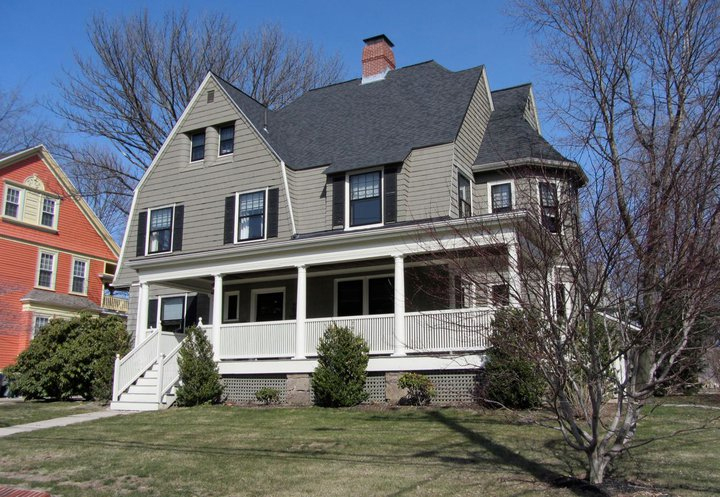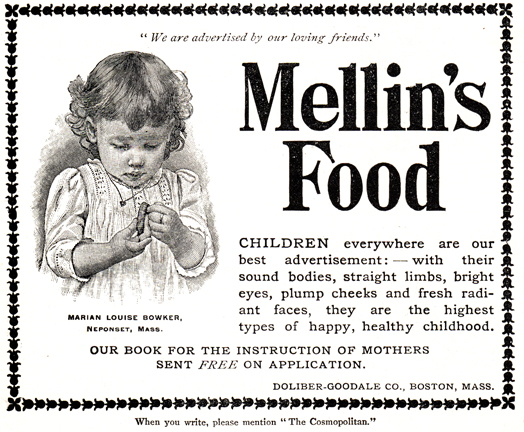Date of construction: 1888 based on the residence of Goodale in the 1889 Boston Directory

Architect: Edwin J. Lewis, Jr. from Shand-Tucci
The following is from Ashmont by Dougass Shand-Tucci
The house on the opposite corner of Elmer Road and Carruth, 10 Carruth, the Goodale House, and 15 Carruth, the Captain Boyd House, in front of which is our vantage point, are also Shingle Style (in the case of 15, only in feeling; it is clapboarded) and make an excellent comparison because both were designed by Edwin J. Lewis for Thomas H. Goodale, Jr. A partner in Doliber, Goodale and Co., intown merchants, Goodale was for ears the esteemed Junior Warden of All Saints’, as well as a member of the committee that raised the funds to build the present church. Moreover, his wife, Susan, was a leading light of every other organization in the parish. Ten Carruth was their own home, designed by Lewis in 1888 and thus among his earliest works. It is quite a tour de force for a man of twenty-nine to have pulled off so complicated a composition of gambrel profiles compounded by het more gambrel profiles and by parts of the same, whichever way, seemingly, one looks. The two-story gambrel was, indeed, rather an innovative organizing idea n the 1880s; in fact, Lewis was probably among the first to use the motif in the early eighties when he was at Peabody and Stearns. But it all is just a little too complicated!
The following is from the inventory form for Carruth Street – Peabody Square
10 and 15 Carruth Street were designed by Dorchester architect Edwin J. Lewis, Jr. for Susan and Thomas H. Goodale. The Goodale’s resided in the former while the latter was built as an investment property for immediate sale. Built in 1888, 10 Carruth Street represents one of Lewis’ earliest documented works. Thomas H. Goodale, Jr. was a partner in Doliber, Goodale and Co., Boston merchants and was for years the Junior Warden of All Saints’; he was a member of the committee that raised the funds to build the present church. Additionally, Goodale’s wife Susan was a leader in a number of All Saints’ organizations.
The following is from the Dorchester Historical Society’s Dorchester House Tour Ashmont/Carruth Street Neighborhood, June 11, 2017
Year built: 1888
Architect: Edwin J. Lewis, Jr.
Style: Shingle Style
This Shingle Style house is one of Edwin J. Lewis, Jr.’s earliest designs after he set up his own practice in 1887. In his youthful exuberance, he created a complex roofline with intersecting gambrels, into which he deftly integrated several dormers and an octagonal turret. The wraparound porch with his signature railings was partially enclosed to make a bedroom when the house was converted to two apartments, its status from about 1940 to 20000. The last two owners have carried out exemplary renovations to restore its original elegance as a single-family home.
Inside, a full Classical entablature of quarter-sawn oak runs around the entry hall. The monumental fireplace is flanked by Doric columns; another Doric column stands at the foot of the stairs. In contract, the staircase balusters are very delicate, with bamboo-like rings. This grand space was previously bisected by a wall added to create a separate apartment entrance. In the parlor, the current owners have installed built-in shelves that match the scale and quality of the foyer’s woodwork The living room has a corner fireplace and an alcove tucked into the octagonal bay. The dining room woodwork is gum, stained quite dark; the corner fireplace helps give this room its distinctive octagonal shape. The original pantries and kitchen have been reconfigured into an inviting space with plenty of room for gathering and cooking. The china closet has been preserved; a second pantry was replaced by a bath. A chimney was removed and the service stair hall opened up, enhancing the airy feel, as do the luxurious stone and tilework in light colors.
The main staircase passes in front of the stained glass window in an unusual “floating” form; structurally, this may have been a bit too daring, as the stair has settled over time. Two rooms linked by an arched opening for the master suite. Three other bedrooms, a laundry room, and a modern bath round out this floor. On the third floor, notice the marble corner sink in the former maid’s room, and the toilet tucked into a closet.
The house was built for Thomas and Susan Goodale, active All Saints parishioners; Thomas was deeply involved in raising money to build the new church. From his front porch, he had a perfect view down Lombard Street to All Saints’ earlier wooden church on Dorchester Avenue; he could also monitor progress on the construction of the imposing new stone church less than a block away, which he worked so hard to bring about.
Comment from: Thomas Hanlon
This is the Thomas and Susan Goodale home built in 1888 by a design of Edwin Lewis Jr.
The home had, for the first twenty years, two live-in maids. This is according to the census of 1890, 1900, and 1910.
In 1917 Susan Goodale, who was living on Linnaen St in Cambridge, put a new roof on the home. I assume that she was leasing it out at the time or that one of her sons and his family were living there.
By 1920 the home was owned by Robert Cleaves who lived there with his family and one maid.
I had not been able to find any information regarding the home until I located a building permit dated July 12, 1940 when the owner was an Andrew Keegan who changed the home to a two-family and built a two-car garage on the side of the property facing on Elmer Rd. This foreclosure postcard may indicate that the Cleaves’ were foreclosed on but I don’t know that for a fact.
The home was sold sometime in the 60’s to the Flaherty Family. The next owner was Inga Bernstein who renovated it back to an approximation of it’s original appearance as a one-family home.
The home is now owned by Thomas and Susan Hanlon. The namesakes of the original owners!
Owners from maps:
1884 no house on the map, lot was part of a large parcel owed by the heirs of Cheever Newhall.
1889 Susan Goodale
1894 Susan H. A. Goodale
1898 Susan H. A. Goodale
1904 Susan H. A. Goodale
1910 Susan H. A. Goodale
1918 Susan H. A. Goodale
1933 Robert Cleaves
Deed
Dec. 20, 1887 from Charles F. Kittredge to Susan H. A. Goodale, wife of Thomas T. Goodale 1803.577 Lot 1 pl 1745.157
parcel of land, no mention of building
Boston Directories
1888 Thomas T. Goodale (Doliber, Goodale, & Co.), Mellin’s Food, 40 to 43 Central shf. h. 2 King, Dor
1889 Thomas T. Goodale, pres. Doliber-Goodale Co., Mellin’s Food, 40 to 43 Central wharf, h. 10 Carruth


The following is from Goods for Sale: Products and Advertising in the Massachusetts Industrial Age by Chaim M. Rosenberg (2007), 123.
With the beginning of the scientific age, the search for a good alternative to mother’s milk gathered speed. The German scientist Justus von Liebig is credited with being the first, in 1867, to offer for sale an “ideal” infant food. His formula was a blend of cow’s milk, wheat flour, and malt flour, mixed with bicarbonate of potash. Gustav Mellin in England modified Liebig’s formula. Prepared infant food was a boon to working mothers who left their nursing children in the hands of grand-parents during the day. Mellin’s Food for the Infant became popular in the United States. It was marketed by Theodore Metcalf of Boston at the cost of sixty-five cents a container. Around 1880 the agency for Mellins’ baby food was taken over by Thomas Doliber and Thoms T. Goodale, two of Metcalf’s employees. Doliber-Goodale & Co., was located at 40-43 Central Wharf on Boston’s waterfront. Its motto was “ora et labora” (pray and labor). The company advertised Mellin’s Food as “the only perfect substitute for Mother’s milk.” Made from dried malt extract, Mellin’s Food claimed to give the baby “strength and vitality” while preventing colic and constipation. Later, the market for Mellin’s Food was expanded to include the elderly, invalids, and dyspeptics.
Census
1910 10 Carruth Street
Thomas T. Goodale, 55, treasurer in mining [?]
Susan H. Goodale, 56
Charles J. Goodale, 31, clerk in broker’s office
Mildred Goodale, 22
Arthur H Goodale, 24, clerk in broker’s office
Nellie Garrity, 22, servant
Katherine McDonald, 50, servant

